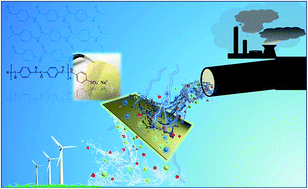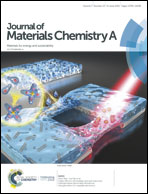Thin and robust organic solvent cation exchange membranes for ion separation†
Abstract
A thin and robust organic solvent cation exchange membrane (CEM) was successfully fabricated for the first time using dissolved Kevlar aramid nanofibers as the casting solution and 4-aminobenzenesulfonic acid (ABS) as the negatively charged functional group via an amide condensation reaction. The synthesized Kevlar CEMs inherited the advantages of Kevlar aramid nanofibers, achieving an excellent ion exchange capacity as high as 1.0 mmol g−1 (with 22.5% water content), a low swelling rate of ∼2.0%, a low membrane surface electrical resistance of 2.95 Ω cm2, a high mechanical strength of over 9.0 kPa of a water column (the membrane thickness was 5.0 μm) and a high membrane limiting current density of 45.0 mA cm−2 (in 0.1 M NaCl solution). In electrodialysis, the Kevlar CEMs demonstrated an exceptional cation/anion separation in dilute and concentrated cells. After 72 h of immersion in aqueous acetone solutions (25%, 50%, 75% and 100%, Vacetone/Vwater), the resulting membranes still exhibited a significant separation in ED. This work demonstrates the promising potential application of Kevlar aramid nanofibers in the preparation of organic solvent CEMs.



 Please wait while we load your content...
Please wait while we load your content...